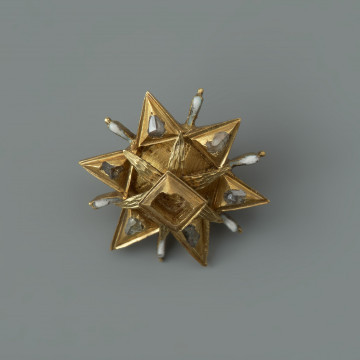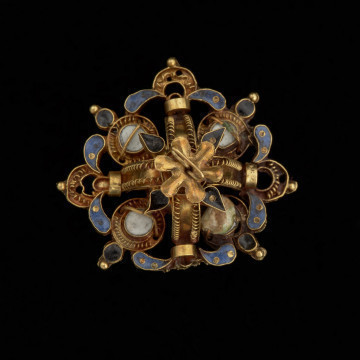
Star-shaped dress jewellery
nie po 1637
National Museum in Szczecin
Part of the collection: Jewels and costumes of Pomeranian dukes
The ornaments of Francis I's cap, like other jewels from the ducal sarcophagi in Szczecin, have material, historical, and artistic value. All of them are the jewellery of the highest quality, made by outstanding artists for the rulers of the Griffin dynasty. The jewels from Francis I's cap are attributed to a Hamburg goldsmith, Jacob Mores the Elder, active in the 4th quarter of the 16th century and at the beginning of the 17th century, commissioned, among others, by the Kings of Denmark, Electors of Saxony and Dukes of Schleswig-Holstein. Some researchers also point to analogies with designs by the famous Augsburg goldsmith, Daniel Mignot.Rosettes from Szczecin are distinguished by a lightness of openwork and extremely harmonious composition. They are made mainly of Schweifwerk forms. From the 1670s, massive roll-edge decorations started to evolve in jewellery towards decorations with lighter, softened forms. A unique feature of the new ornament called Schweifwerk was the bold, fleshy ends of the curves. Francis I’s jewels are an example of the late Schweifwerk structures of the early 17th century, with interpenetrating, expressively drawn, ellipsoidal forms. Colourful enamel of many shades, applied in such a way as to emphasise the finesse of Mannerist shapes, is an important element of the composition.
Monika Frankowska-Makała
Author / creator
Dimensions
cały obiekt: height: 2,3 cm, width: 4,5 cm
Object type
headgear adornment, jewellery
Creation time / dating
Creation / finding place
Identification number
Location / status

nie po 1637
National Museum in Szczecin

nie po 1637
National Museum in Szczecin

około 1600
National Museum in Szczecin
DISCOVER this TOPIC
Castle Museum in Łańcut
DISCOVER this PATH
Educational path